Design of Robust Broadband Frequency-Invariant Broadside Beampatterns for the Differential Loudspeaker Array
Abstract
1. Introduction
2. Problem Formulation
3. Methods
3.1. Target Broadside Radiation Pattern
3.1.1. Target Broadside Radiation Pattern with the Null Information
3.1.2. Target Broadside Radiation Pattern with Maximum Directivity Factor
3.1.3. Target Broadside Radiation Pattern with Equal Sidelobe Level
3.2. Beamformer Design
4. Simulations
4.1. The 2Nth-Order Broadside Differential Beamformer Synthesized by the Proposed Method
4.2. Effect of the Regularization on the Proposed Method
4.3. Performance Comparison
4.3.1. Comparison with MM-JAD (the Method in [29])
4.3.2. Performance Comparison between MM-JAD and the Proposed Method with the Perturbations Added to the Spatial Responses of the Loudspeakers
4.3.3. Comparison with the Other Differential Beamforming Methods
5. Experiments
5.1. Experimental Setup
5.2. Results and Discussion
5.2.1. Comparison with Other Broadside Differential Beamforming Methods
5.2.2. Comparison with the Method in Ref. [29] (MM-JAD) at Low Frequencies
5.2.3. Comparison with Benchmark Beamforming Methods
6. Conclusions
Author Contributions
Funding
Institutional Review Board Statement
Informed Consent Statement
Data Availability Statement
Conflicts of Interest
References
- Perla, J.; Bulla, W. A qualitative investigation of soundbar theory. In Proceedings of the Audio Engineering Society Convention 147, New York, NY, USA, 16–19 October 2019. [Google Scholar]
- Pan, K.; Huang, J.; Cheng, J.; Shen, Y. Loudspeaker array beamforming for sound projection in a half-space with an impedance boundary. J. Acoust. Soc. Am. 2023, 153, 1626–1636. [Google Scholar] [CrossRef]
- Brunskog, J.; Heuchel, F.M.; Nozal, D.C.; Song, M.; Agerkvist, F.T.; Fernandez-Grande, E.; Gallo, E. Full scale outdoor concert adaptive sound field control. In Proceedings of the 23rd International Congress on Acoustics(ICA), Aachen, Germany, 9–13 September 2019; pp. 1170–1177. [Google Scholar]
- Start, E. Loudspeaker Matrix Arrays: Challenging the way we create and control sound. In Proceedings of the Audio Engineering Society Conference: AES 2024 International Acoustics & Sound Reinforcement Conference, Le Mans, France, 23–26 January 2024. [Google Scholar]
- Zhu, Q.; Qiu, X.; Coleman, P.; Burnett, I. A comparison between two modal domain methods for personal audio reproduction. J. Acoust. Soc. Am 2020, 147, 161–173. [Google Scholar] [CrossRef] [PubMed]
- Huang, Y.; Zhao, S.; Lu, J. Acoustic contrast control with a sound intensity constraint for personal sound systems. J. Acoust. Soc. Am. 2024, 155, 879–890. [Google Scholar] [CrossRef] [PubMed]
- Kim, Y.-H.; Choi, J.-W. Sound Visualization and Manipulation; John Wiley & Sons: Hoboken, NJ, USA, 2013. [Google Scholar]
- Chen, J.; Benesty, J.; Pan, C. On the design and implementation of linear differential microphone arrays. J. Acoust. Soc. Am 2014, 136, 3097–3113. [Google Scholar] [CrossRef] [PubMed]
- Zhao, L.; Benesty, J.; Chen, J. Design of robust differential microphone arrays with the Jacobi–Anger expansion. Appl. Acoust. 2016, 110, 194–206. [Google Scholar] [CrossRef]
- Jin, J.; Huang, G.; Wang, X.; Chen, J.; Benesty, J.; Cohen, I. Steering Study of Linear Differential Microphone Arrays. IEEE/ACM Trans. Audio Speech Lang. Process. 2021, 29, 158–170. [Google Scholar] [CrossRef]
- Elko, G.W. Superdirectional Microphone Arrays. In Acoustic Signal Processing for Telecommunication; Springer: Berlin, Germany, 2000. [Google Scholar]
- Luo, X.; Jin, J.; Huang, G.; Chen, J.; Benesty, J. Design of Steerable Linear Differential Microphone Arrays With Omnidirectional and Bidirectional Sensors. IEEE Signal Process. Lett. 2023, 30, 463–467. [Google Scholar] [CrossRef]
- Pan, C.; Benesty, J.; Chen, J. Design of robust differential microphone arrays with orthogonal polynomials. J. Acoust. Soc. Am. 2015, 138, 1079–1089. [Google Scholar] [CrossRef] [PubMed]
- Yu, G. Eigenbeam-space transformation based steerable differential beamforming for linear arrays. Signal Process. 2023, 212, 109171. [Google Scholar] [CrossRef]
- Huang, G.; Chen, J.; Benesty, J. Insights Into Frequency-Invariant Beamforming With Concentric Circular Microphone Arrays. IEEE/ACM Trans. Audio Speech Lang. Proc 2018, 26, 2305–2318. [Google Scholar] [CrossRef]
- Wang, J.; Yang, F.; Li, J.; Sun, H.; Yang, J. Mode matching-based beamforming with frequency-wise truncation order for concentric circular differential microphone arrays. J. Acoust. Soc. Am. 2023, 154, 3931–3940. [Google Scholar] [CrossRef] [PubMed]
- Luo, X.; Jin, J.; Huang, G.; Zhao, Y.; Chen, J.; Benesty, J. On the Design of Planar Differential Microphone Arrays with Specified Beamwidth or Sidelobe Level. In Proceedings of the ICASSP 2024—2024 IEEE International Conference on Acoustics, Speech and Signal Processing (ICASSP), Seoul, Republic of Korea, 14–19 April 2024; pp. 8536–8540. [Google Scholar]
- Wang, J.; Yang, F.; Yan, Z.; Yang, J. Design of frequency-invariant uniform concentric circular arrays with first-order directional microphones. Signal Process. 2024, 217, 109330. [Google Scholar] [CrossRef]
- Albertini, D.; Bernardini, A.; Borra, F.; Antonacci, F.; Sarti, A. Two-Stage Beamforming With Arbitrary Planar Arrays of Differential Microphone Array Units. IEEE/ACM Trans. Audio Speech Lang. Process. 2023, 31, 590–602. [Google Scholar] [CrossRef]
- Itzhak, G.; Cohen, I. Differential constant-beamwidth beamforming with cube arrays. Speech Commun. 2023, 149, 98–107. [Google Scholar] [CrossRef]
- Zhao, X.; Huang, G.; Chen, J.; Benesty, J. Design of 2D and 3D Differential Microphone Arrays With a Multistage Framework. IEEE/ACM Trans. Audio Speech Lang. Process. 2023, 31, 2016–2031. [Google Scholar] [CrossRef]
- Zhao, X.; Luo, X.; Huang, G.; Chen, J.; Benesty, J. Differential Beamforming with Null Constraints for Spherical Microphone Arrays. In Proceedings of the ICASSP 2024—2024 IEEE International Conference on Acoustics, Speech and Signal Processing (ICASSP), Seoul, Republic of Korea, 14–19 April 2024; pp. 776–780. [Google Scholar]
- Wang, X.; Benesty, J.; Chen, J.; Huang, G.; Cohen, I. Beamforming with Cube Microphone Arrays Via Kronecker Product Decompositions. IEEE/ACM Trans. Audio Speech Lang. Process. 2021, 29, 1774–1784. [Google Scholar] [CrossRef]
- Choi, J.-W.; Kim, Y.; Ko, S.; Kim, J. A differential approach for the implementation of superdirective loudspeaker array. In Proceedings of the Audio Engineering Society Convention 128, London, UK, 22–25 May 2010. [Google Scholar]
- Choi, J.W. Generation of a Near-field Sound Zone Using Broadside Differential Array. In Proceedings of the 2021 Immersive and 3D Audio: From Architecture to Automotive (I3DA), Bologna, Italy, 8–10 September 2021. [Google Scholar]
- Wang, J.; Zhang, W.; Pan, C.; Chen, J.; Benesty, J. On the design of differential loudspeaker arrays with broadside radiation patterns. JASA Express Lett. 2021, 1, 084804. [Google Scholar] [CrossRef] [PubMed]
- Zhang, Y.; Mao, J.; Cai, Y.; Ye, C. Sound reproduction with a circular loudspeaker array using differential beamforming method. In Proceedings of the 2022 Asia-Pacific Signal and Information Processing Association Annual Summit and Conference (APSIPA ASC), Chiang Mai, Thailand, 7–10 November 2022; pp. 143–148. [Google Scholar]
- Miotello, F.; Bernardini, A.; Albertini, D.; Antonacci, F.; Sarti, A. Steerable First-Order Differential Loudspeaker Arrays with Monopole and Dipole Elements. In Proceedings of the Convention of the European Acoustics Association, Forum Acusticum, Turin, Italy, 11–15 September 2023; pp. 11–15. [Google Scholar]
- Zhang, Y.; Mao, J.; Cai, Y.; Ye, C.; Zhu, Q. Broadband frequency-invariant broadside beamforming with a differential loudspeaker array. In Proceedings of the 2023 31st European Signal Processing Conference (EUSIPCO), Helsinki, Finland, 4–8 September 2023; pp. 1728–1732. [Google Scholar]
- Pan, C.; Chen, J.; Benesty, J.; Shi, G. On the Design of Target Beampatterns for Differential Microphone Arrays. IEEE/ACM Trans. Audio Speech Lang. Process. 2019, 27, 1295–1307. [Google Scholar] [CrossRef]
- Macdonald, I.G. Symmetric functions and Hall polynomials; Oxford University Press: Oxford, UK, 1998. [Google Scholar]
- Zhao, X.; Huang, G.; Chen, J.; Benesty, J. An improved solution to the frequency-invariant beamforming with concentric circular microphone arrays. In Proceedings of the ICASSP 2020-2020 IEEE International Conference on Acoustics, Speech and Signal Processing (ICASSP), Barcelona, Spain, 4–8 May 2020; pp. 556–560. [Google Scholar]
- Bitzer, J.; Simmer, K.U. Superdirective microphone arrays. In Microphone Arrays: Signal Processing Techniques and Applications; Springer: Berlin/Heidelberg, Germany, 2001; pp. 19–38. [Google Scholar]
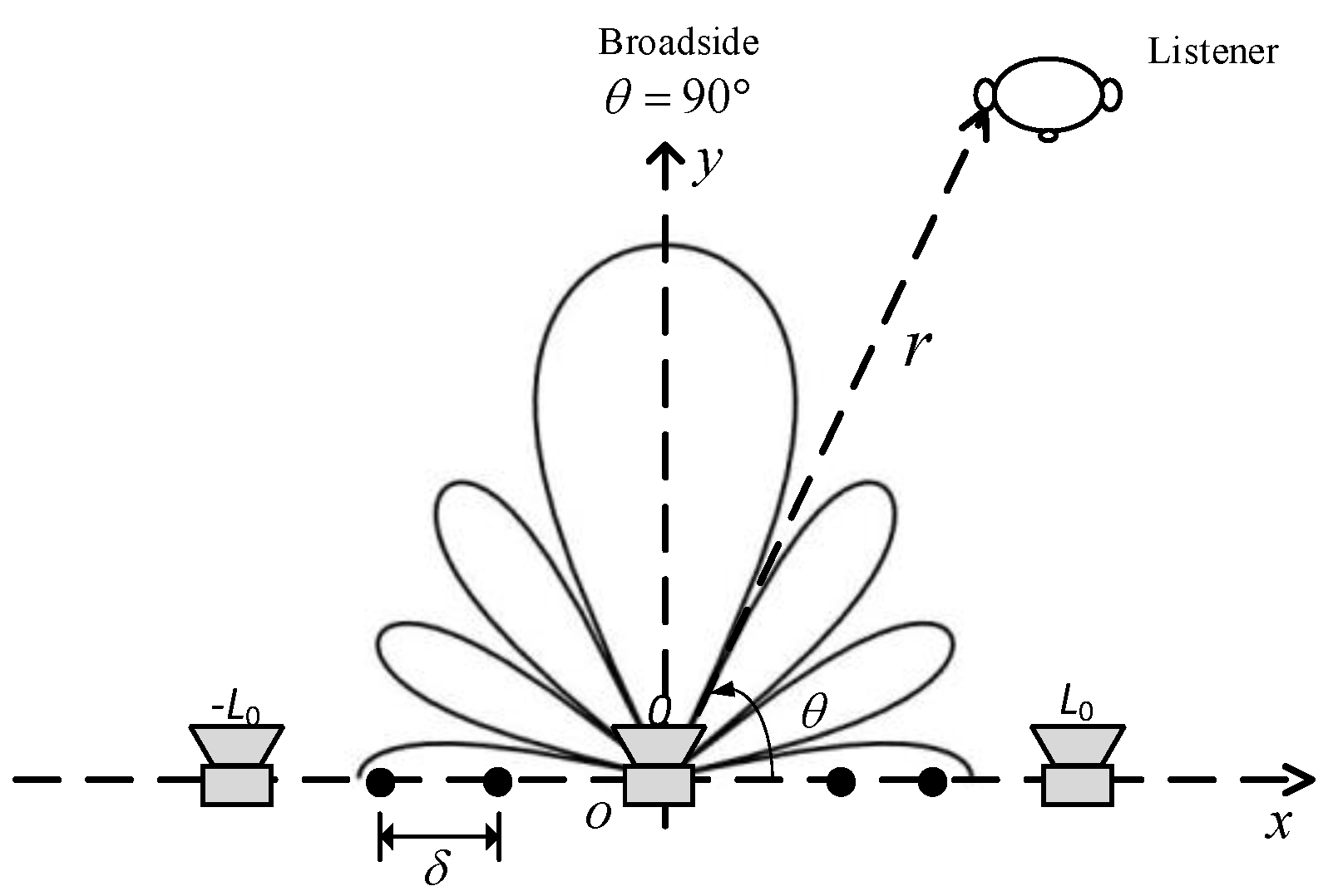









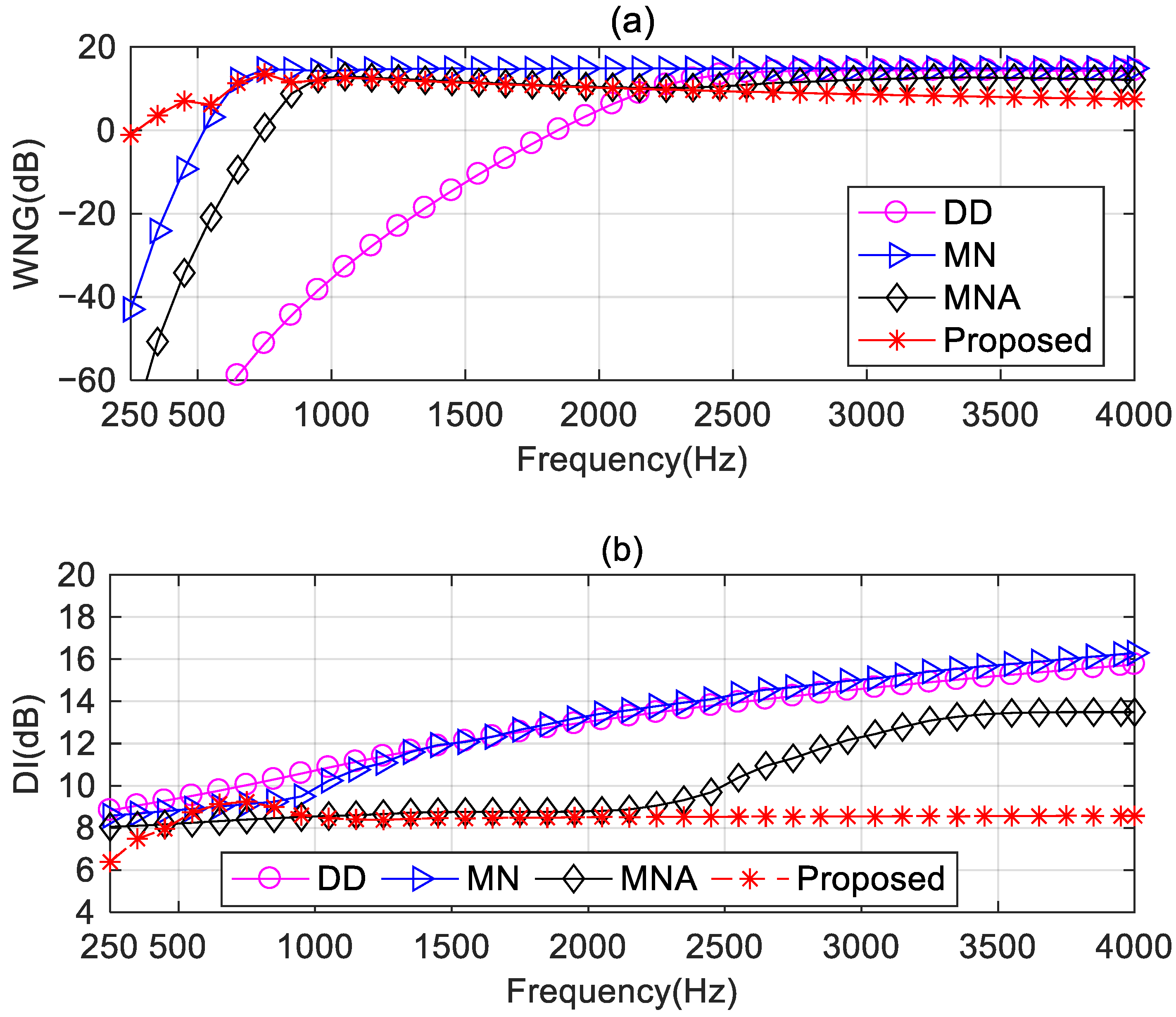
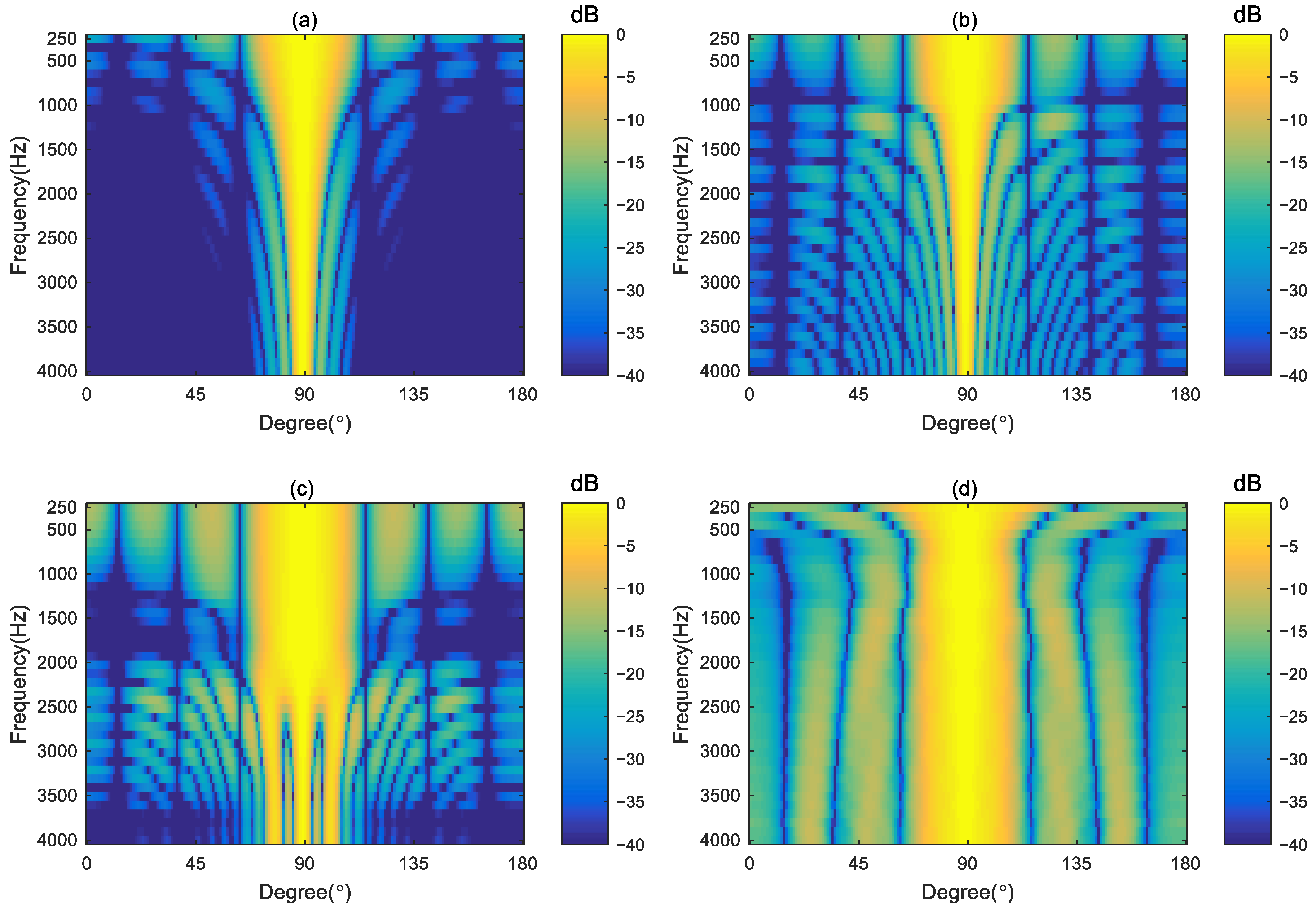

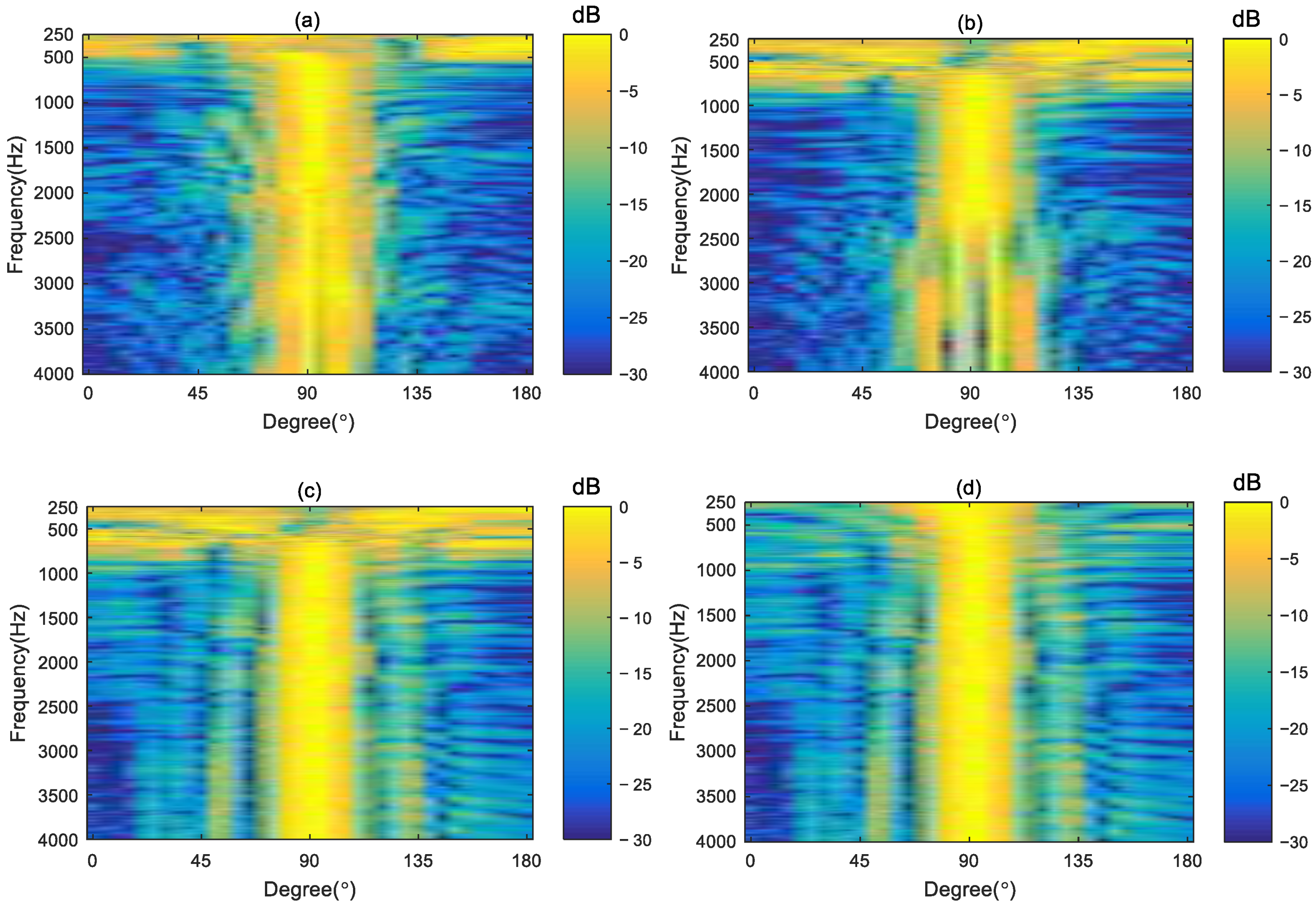
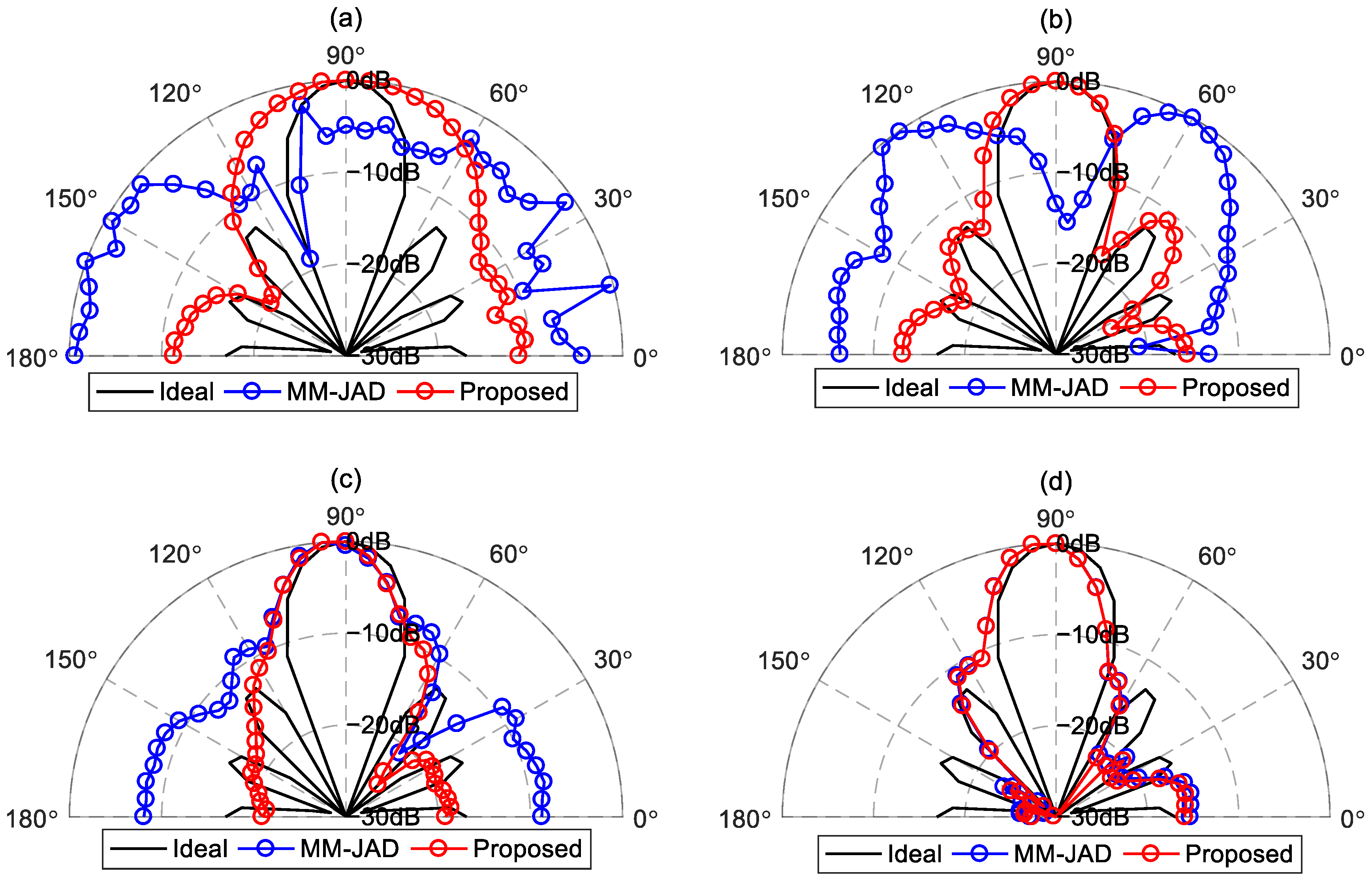

| Freq (Hz) | WNG (dB) | DI (dB) | ||
|---|---|---|---|---|
| -MM-JAD | Proposed | -MM-JAD | Proposed | |
| 250 | −61.8 | −1.1 | 8.5 | 6.4 |
| 500 | −24 | 5.8 | 8.5 | 8.3 |
| 750 | −0.1 | 13.6 | 8.4 | 9.2 |
| 1000 | 12.1 | 12.4 | 8.4 | 8.5 |
| Freq (Hz) | WNG (dB) | DI (dB) | ||
|---|---|---|---|---|
| -MM-JAD | Proposed | -MM-JAD | Proposed | |
| 250 | −15.6 | −1.1 | −1.8 | 5.6 |
| 500 | −15.4 | 5.8 | −2.1 | 8.1 |
| 750 | 0.3 | 14.0 | 7.3 | 9.2 |
| 1000 | 12.6 | 12.8 | 8.3 | 8.4 |
Disclaimer/Publisher’s Note: The statements, opinions and data contained in all publications are solely those of the individual author(s) and contributor(s) and not of MDPI and/or the editor(s). MDPI and/or the editor(s) disclaim responsibility for any injury to people or property resulting from any ideas, methods, instructions or products referred to in the content. |
© 2024 by the authors. Licensee MDPI, Basel, Switzerland. This article is an open access article distributed under the terms and conditions of the Creative Commons Attribution (CC BY) license (https://creativecommons.org/licenses/by/4.0/).
Share and Cite
Zhang, Y.; Wei, H.; Zhu, Q. Design of Robust Broadband Frequency-Invariant Broadside Beampatterns for the Differential Loudspeaker Array. Appl. Sci. 2024, 14, 6383. https://doi.org/10.3390/app14146383
Zhang Y, Wei H, Zhu Q. Design of Robust Broadband Frequency-Invariant Broadside Beampatterns for the Differential Loudspeaker Array. Applied Sciences. 2024; 14(14):6383. https://doi.org/10.3390/app14146383
Chicago/Turabian StyleZhang, Yankai, Hongjian Wei, and Qiaoxi Zhu. 2024. "Design of Robust Broadband Frequency-Invariant Broadside Beampatterns for the Differential Loudspeaker Array" Applied Sciences 14, no. 14: 6383. https://doi.org/10.3390/app14146383
APA StyleZhang, Y., Wei, H., & Zhu, Q. (2024). Design of Robust Broadband Frequency-Invariant Broadside Beampatterns for the Differential Loudspeaker Array. Applied Sciences, 14(14), 6383. https://doi.org/10.3390/app14146383






